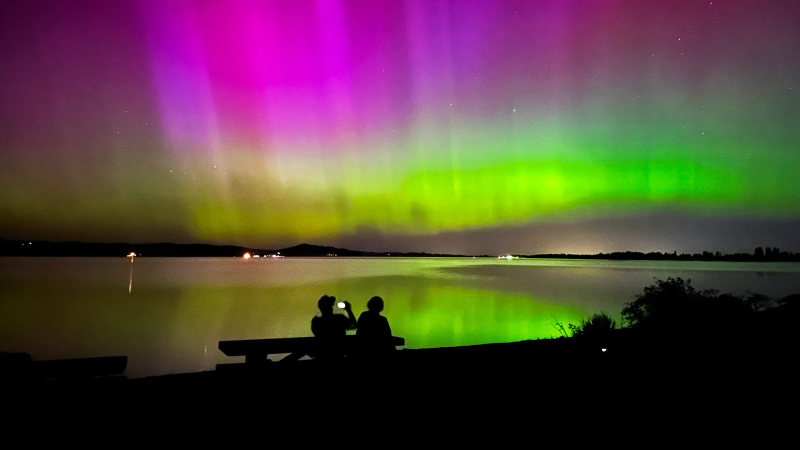Will we see the northern lights again Sunday? Here's the forecast
The northern lights dazzled Americans again Saturday night with flashes of green, purple and pink lighting up the night sky in much of the northern United States, though the display didn't appear as brilliant or reach as far south as on Friday.
Spectacular views could be in store Sunday for a third night in a row, forecasters said.
"The ongoing geomagnetic storm will likely once again become more intense later today," the Space Weather Prediction Center posted on X Sunday. During periods of stronger geomagnetic storm conditions, the aurora is more widespread and seen at lower latitudes.
The center's experimental forecast map shows the aurora may be visible Sunday in New England, the Midwest, the Upper Plains and the Pacific Northwest regions. The streaks of light may be seen as far South as Iowa and Nebraska.
If you missed the view on Friday or Saturday due to cloud cover, you might be in luck Sunday, AccuWeather senior meteorologist Tom Kines told USA TODAY. The Northeast and Mid-Atlantic regions, blanketed by clouds for most of the last two nights, should have a much clearer view of any aurora activity, but clouds may block it if you live in the center of the country.
Americans across the country shared stunning photos of the dancing lights from Friday and Saturday nights.
Tips for seeing the auroras
The best aurora viewing is typically within an hour or two of midnight, local time, according to the National Oceanic and Atmospheric Administration, the parent agency of the Space Weather Prediction Center.
- Find an area with the darkest skies possible.
- Look to the north.
- Even if the dancing lights aren't visible to the naked eye, people on Friday night could seem them through their cell phone cameras, set for night viewing.
- The auroras aren't constant, so if you don't see it in 15 minutes of watching, that doesn't mean you won't see it later in the evening.
- The hours expand toward evening and morning as the level of geomagnetic activity increases.
What is causing the northern lights this weekend?
The spectacle is being caused by geomagnetic storms that erupt from a sunspot cluster on the sun.
The storm was unusually strong — classified as "extreme" (or a G5) storm, the highest level, the Space Weather Prediction Center said Friday evening. It's the first G5 storm to hit our planet since 2003.
"There have been reports of power grid irregularities and degradation to high-frequency communications and GPS," the Space Weather Prediction Center said in a Saturday update.

NASA describes an aurora as an "intricate dance of particles and magnetism between the Sun and the Earth." The reason the auroras move is because of how the Sun's ionized gases interact with the Earth's magnetic field.
Coronal ejections are large expulsions of plasma and magnetic field from the Sun’s corona, according to NOAA. The expulsions eject billions of tons of coronal material that expands as it travels away from the Sun. The fastest-traveling ejections can reach the Earth in as little as 15 to 18 hours.
What are the chances of seeing an aurora based on?
Besides the clear weather and dark skies needed for peak aurora viewing, the chances grow over a larger area when the levels of geomagnetic storm activity are highest.
Just like the National Oceanic and Atmospheric Administration uses a scale to measure the strength of hurricanes and tornadoes, it also uses a scale to rate the strength of geomagnetic storms, when coronal mass ejections from the sun reach the outer layers of the earth's atmosphere.
A G 5 (extreme) rating represents the greatest chances of seeing auroras over the greatest expanse of the Earth. That's what happened on Friday night, when people saw the aurora in the Florida Keys and Mexico. The hours of potential viewing expand toward evening and morning as the level of geomagnetic activity increases.
On Saturday night, the observed scale was a G 3 (Strong).
On Sunday night, NOAA predicts it's possible that storm activity will reach G 4 (Severe.) Several intense coronal mass ejections are expected to reach the Earth's atmosphere later today.
'2 incredible spectacles of the universe': Northern lights come about a month after eclipse
Seeing such a strong aurora is highly unusual this far south, said Antonella Fruscione, an astrophysicist at Harvard University.
"It's a very rare occurrence, especially because (Friday) night it was really visible," Fruscione said.
Seeing the aurora amazed Fruscione. She sent photos of the sight as well as the April total solar eclipse to her friends in Italy.
Fruscione and a group of friends from the U.S. and Europe traveled from her home in Boston to northern New Hampshire to see the April 8 eclipse on the path of totality.
"I said, 'Can you imagine how fortunate I was this year, one month apart, I see these two incredible spectacles of the universe,'" she recalled telling her friends.

Tips for viewing aurora borealis
The best time to view the aurora is generally within one to two hours of midnight, but these hours stretch earlier into evening and later into morning with increased levels of geomagnetic activity, the Space Weather Prediction Center said.
To get the best view, it must be dark, experts say. You won't see aurora in daylight. You should also try to get away from the light pollution of a big city, Kines said. The darker it is, the better the view, though some people reported seeing bright aurora activity from metro areas like Milwaukee and Detroit on Friday.
Even the brightness of a full moon can diminish the spectacle. Luckily, the moon is only a crescent this weekend.
Disclaimer: The copyright of this article belongs to the original author. Reposting this article is solely for the purpose of information dissemination and does not constitute any investment advice. If there is any infringement, please contact us immediately. We will make corrections or deletions as necessary. Thank you.





